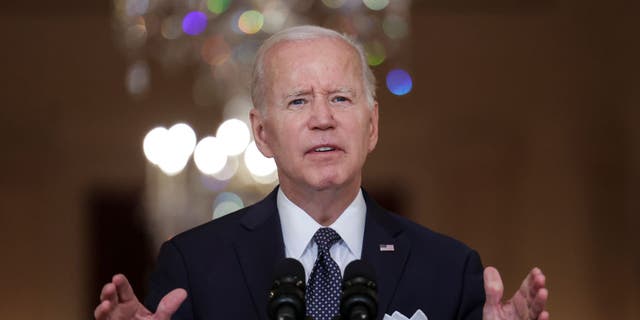
NEWYou can now listen to Fox News articles!
It is said that for every action there is a reaction.
But historically, that hasn’t been the case when Congress tried to advance legislation in the aftermath of mass shootings.
We have heard for decades now that after a particular mass shooting “things will be different.”
They rarely are.
But, this time may be a little different.
This doesn’t mean Congress will get something done. But the machinations in the wake of the shootings in Buffalo, New York, Uvalde, Texas, and Tulsa, Oklahoma, are different.
Lawmakers are engaged in the most serious discussions about possible gun legislation in years. This is crucial – even if nothing ever passes. Following the Columbine rampage in 1999, the Senate approved a plan to require background checks for weapons sold at gun shows – with Vice President Al Gore casting the tie-breaking vote. Senators then stuffed the gun show provision into a broader bill that passed. But the House defeated the measure to require background checks for weapons sold at gun shows.
HOUSE COMMITTEE PREPS GUN CONTROL PACKAGE AFTER MASS SHOOTINGS IN BUFFALO, TEXAS AND TULSA
Congress did pass a bill to improve the National Instant Criminal Background Check System (NICS) following the mass shooting at Virginia Tech in 2007.
But those modest efforts have been it.

President Joe Biden delivers remarks on the recent mass shootings from the White House on June 2, 2022. (Kevin Dietsch/Getty Images)
Conversations were silent about legislation following the shooting of former Rep. Gabrielle Giffords, D-Ariz., in 2011 and House Minority Whip Steve Scalise, R-La., in 2017. It took the Senate until April 2013 to even vote on legislation that was doomed to fail – four months after the massacre at Sandy Hook Elementary in Newton, Connecticut, in December 2012.
Note that I’m pointing to legislation here. Not necessarily “protests.”
In June, 2016, Sen. Chris Murphy, D-Conn. – who represented Newtown as a congressman – seized the Senate floor for nearly 15 hours to rail against inaction on firearms legislation. Murphy specifically wanted the Senate to consider a bill on enhanced background checks and a measure to bar those on the terrorist watch list from buying guns. It was the tenth-longest speech in Senate history. But technically, Murphy’s oratory was not a filibuster.
PELOSI ANNOUNCES HOUSE HEARING ON ‘ASSAULT WEAPONS’ BAN
Later that same month, late Rep. John Lewis, D-Ga., and Rep. John Larson, D-Conn., along with others, led an all-night sit-in on the House floor to protest inaction on guns.
But these were efforts to generate attention about the issue and spur action. Not actual negotiations.
That’s why the talks between Murphy, Sen. John Cornyn, R-Texas, and a host of other bipartisan senators are key. The sides have mostly talked past one another after each mass shooting. These conversations are different.
It’s significant that House Speaker Nancy Pelosi, D-Calif., initially deferred to the Senate to see if senators could get a deal on a bill to combat gun violence – especially one that could command 60 yeas and overcome two filibusters. Pelosi was willing to take a crack at any Senate-passed bill.
But Pelosi altered her strategy. Rank-and-file Democrats demanded immediate action. Hence, the decision to hold the Judiciary Committee markup on guns and put those bills on the floor in the coming days.
Granted, these bills aren’t going to become law – even though they’ll pass the House. But this new tactic gave Democrats the chance to emphasize what they are for – in a big public forum. Democrats can simultaneously underscore what the GOP opposes. Republicans were more than happy to do that during the hearing.
“Democrats are always fixated on curtailing the rights of law-abiding citizens rather than trying to understand why this evil happens,” argued the top GOPer on the Judiciary Committee, Rep. Jim Jordan, R-Ohio.
THE HITCHHIKER’S GUIDE TO BIPARTISAN TALKS TO FORGE A SOLUTION ON GUN VIOLENCE
“I am unequivocally against red flag laws,” declared Rep. Matt Gaetz, R-Fla., at the Judiciary Committee markup. “They deprive Americans of their Second Amendment rights. They deprive Americans of their Fifth Amendment right to due process.”
But Democrats thought it was important that they showed action. It would serve as a contrast to the GOP response following most shootings. Otherwise, the liberal base could accuse Democrats of not responding.
Still, Democrats must be very careful to make sure that moving these bills in the House doesn’t puncture the fragile Senate talks. In fact, Pelosi is giving her members the chance to pass something – even if it doesn’t become law. Holding the markup on the bills and voting on the floor allows Democrats to flex their muscles on the issue and politically assert themselves. Once this exercise is complete, Democratic leaders hope their members will accept a more modest agreement on firearms coming out of the Senate in the form of “Murphy-Cornyn.”
It is unclear if the House will consider the slate of bills as individual measures or as one omnibus package. There are pros and cons both ways. Individual votes could give even Republican members the chance to vote yes on a few things. That approach also gives Democrats the opportunity to excoriate Republicans who oppose even narrow measures.
Most Republicans could be inclined to vote no on an omnibus package because it’s “one size fits all.” That said, moving a bigger package probably diminishes the chances of Democrats jumping ship. And a larger, unified bill gives the Senate a legislative vehicle with which to work – provided they get a deal.
DEMOCRATS PLEDGE TO PRESS GUN CONTROL TO FOREFRONT OF 2022 MIDTERM ELECTIONS
In other words, the House would pass its package (probably next Wednesday or Thursday) and ship it to the Senate. If the Senate can secure an agreement, it would pass its bill and insert the text into the original House package. The bill would then bounce back to the House to sync up.
Any Senate agreement will lose liberal lawmakers who want to do more on guns and conservative Republicans who want to do less. So the key is the middle. senators at the margins could bolt.
But then the real challenge is getting the House to accept something from the Senate that is scaled back significantly – compared to what the House originally passed. That said, approving the more left-leaning bills gives liberal members something on which to hang their hat. They have voted for something they like. But they may need to swallow hard and accept something far from perfect from the Senate. This is where Pelosi comes in. Her calling card over the years is persuading Democrats to accept less-than-perfect bills – often passing them by narrow margins. Pelosi may be able to persuade members to accept a less than half-loaf from the Senate bakery.
Or…
It’s possible that a substantial coalition of Senate Republicans gives House GOPers air cover. It’s not out of the question that perhaps a small group of House Republicans could support a gun-related issue that doesn’t appeal to liberals. Those progressive members could then vote nay. But the House could pass the bill because moderate Republicans make up the difference.
CLICK HERE TO GET THE FOX NEWS APP
As we say, it’s always about three things: The math. The math. The math.
And there are lots of combinations to get there.








